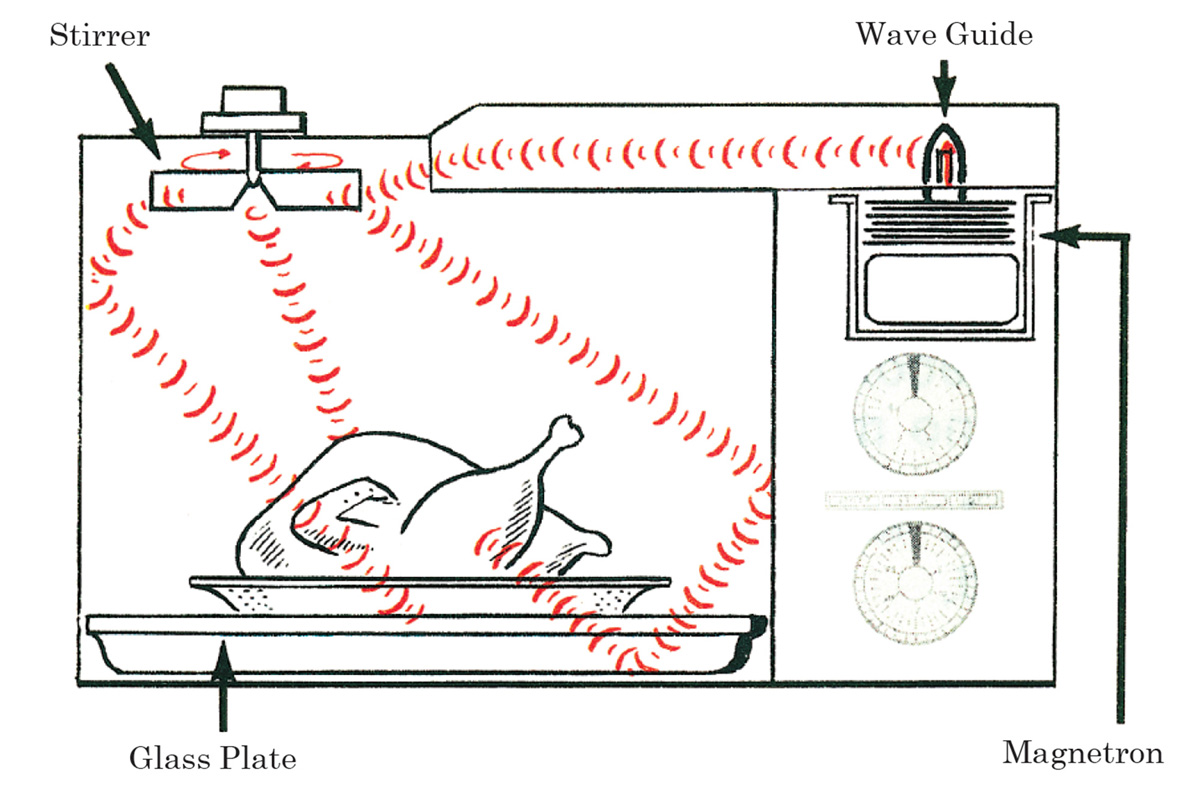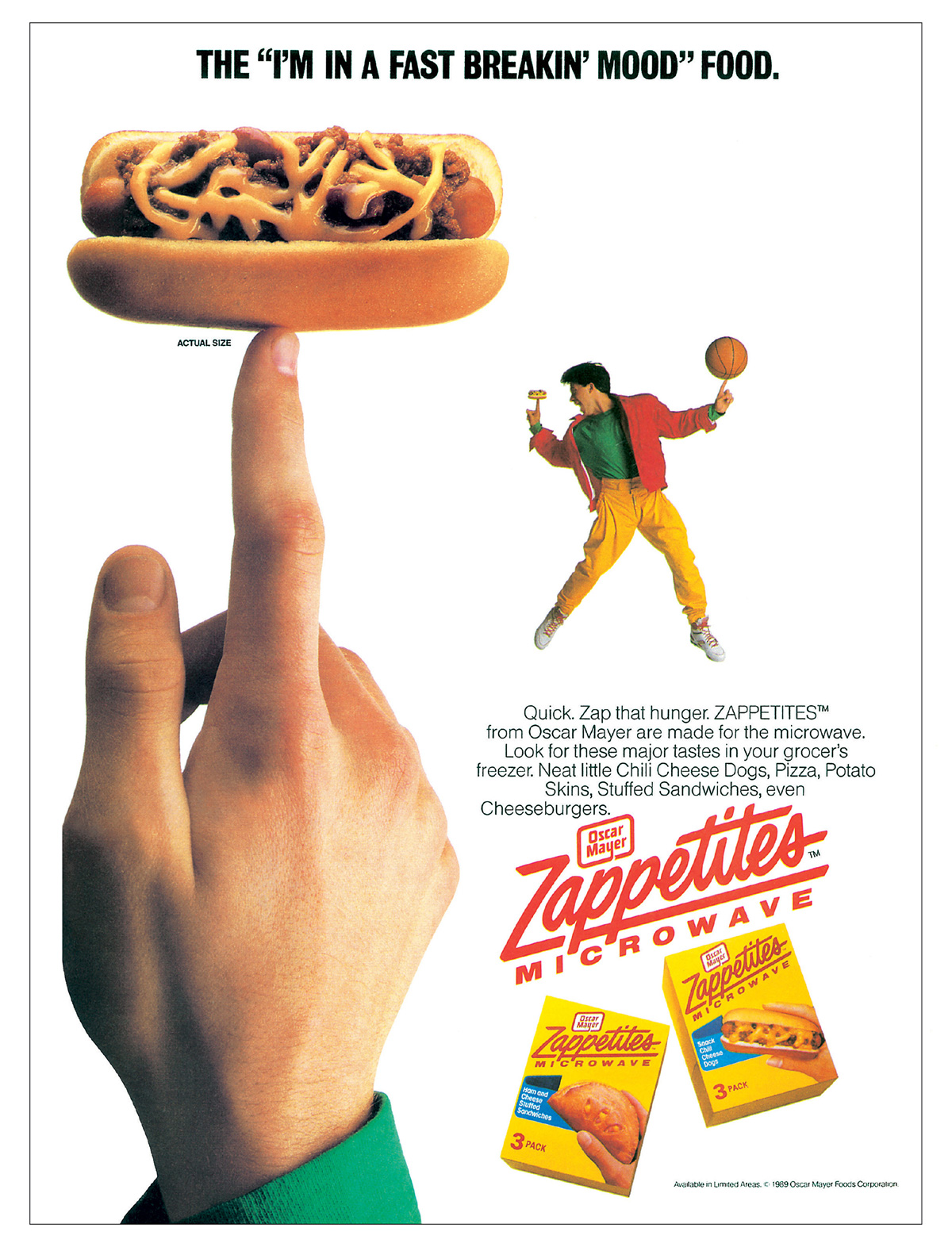Appliance Theory
The uncanny microwave
Jennifer Gabrys

Detailed in forums like “Unwise Microwave Oven Experiments” (a website that is rated for adult content due to the risk involved in the experiments), the list of classic microwave experiments never fails to enchant: “Stand up a CD in your oven and nuke it for about five seconds. Or convert Marshmallow Peeps into monstrous mutants. Slice a grape almost in half and watch it emit a six-inch blowtorch of flaming plasma. Make showers of sparks with steel wool. Swell a chunk of Ivory soap into a blob of crunchy snow. Gamble on racing grapes.”[1] Every object placed in the microwave undergoes a potentially volatile transformation, a molecular vibration that causes objects to flare, heat, and pop with erratic determinacy. What fascinates about the microwave oven are these unpredictable field effects. Here is an electronic appliance that enables permutations of matter through permutations of the electric: transmitting the electromagnetic pulse of microwaves through Peeps and grapes, channeling electric charges, and relaying instructions across digital circuitry.
Under the influence of microwaves, matter transforms, and so mysterious and inconclusive are the effects of this transformation that microwave radiation is often conflated with radioactivity, even though microwaves and gamma rays occupy quite distinct locations on the electromagnetic spectrum. To this day, the long-term effects of microwave radiation are unknown, despite the fact that our atmosphere of communications is nearly saturated with electromagnetic waves. In fact, so many devices are caught in the oscillations of microwave transmission that they begin to interfere with one another’s signals. From pacemakers to mobile phones, electric shavers, and automobile ignition systems, a number of devices transmit signals within the microwave spectrum. While the exact frequency on which each device operates varies, a certain amount of “radar jamming” between devices does occur. Attempts have been made to shield pacemakers, in particular, from cross-communication, but this interference, which extends to a battle between wireless telecommunication networks and microwave ovens, means that you may unexpectedly find yourself in static-ridden communication with your ramen noodles. And to prove that microwave ovens may not be as sealed from leaking signals as they seem, it is possible to place a call to your mobile phone while it is inside a microwave oven (although presumably not while in operation).[2] Coursing across the spectrum and through appliances are electric forces with erratic effects. The microwave oven captures all that is so volatile about these electric charges.
Appliances, those electronic objects, are now pervasive, including everything from refrigerators and washing machines to irons, vacuum cleaners, toasters, kettles, mobile phones, DVD players, personal computers, electrical tools, toys, medical equipment, monitoring and control equipment, automated dispensers, vending machines, ATMs, and on and on. Anywhere there is a machine, chances are it is an electronic appliance. Brown goods, white goods, gray goods. These standard delineations, which are in a certain sense anachronistic, describe the color, durability, and class of appliances. Brown goods were often made with bakelite, a plastic that simulated wood and thereby durability. (One wonders if the microwave oven, that once typically log-brown device, wasn’t some harkening back to the hearths of yore.) But the quiver of electricity through these devices led to goods that would only become more and more transient. The electronic conjoins and augments countless materials and transactions. “E” precedes everything—we have electronic mail, electronic money, and electronic waste. Phones and ovens, cameras and books, leaf blowers and kettles all submit to the same hazy law of the electronic. Every appliance presents an electrical mutation of an object that once stood still, now quickened under the influence of electricity. The post-war history of technology is a legacy of successively intensifying attempts to electrify objects. Electricity animates once-inert objects, transforming them into electronics. Matter is charged, but what does it generate? Here is a general economy of electrification: matter does not just levitate, emanate, conduct, and mobilize; it also circulates, leaks, de-matters, disappears, and wastes. The boundaries of objects break down at the same time as they receive an intensifying jolt.

Like most unusual discoveries, the emergence of the microwave oven came only by accident. Inventor Percy Spencer, upon noticing the “sudden and strange sensation” of a melting candy bar in his pocket while in his laboratory one day, deduced that the magnetron tube, the core technology of radar communication by microwaves, could also be applied to cooking. Where radar had been employed to track enemy aircraft, here it was employed to radiate food for a more rapid transfer from the raw to the cooked. Experiments with the explosion and disarray of “foodstuffs” followed this discovery until the eventual introduction and patenting of the microwave oven in 1947 and 1950 respectively. Various comestibles, including popcorn and eggs, were shot through with radio signals to heat them to a satisfyingly piping temperature. Spencer had discovered the possibility of instant cooking that would influence the taste sensations—and their ready availability—of generations to come.
The first microwave ovens developed from this accidental encounter retailed at $2,000 and were the size of a refrigerator, at nearly six feet tall and weighing 750 pounds. Such massive machines generated 3000 watts of energy, and their name—“Radarange”—expressed their electromagnetic origins. This fantastic merger between military application and home appliance reached a new level when Raytheon took over Amana Refrigeration in 1965. With this move into the “complete home appliance product suite,” Raytheon, through Amana, began to investigate ways for the microwave oven to be distributed in homes across the US. But the microwave oven’s pervasiveness did not occur simply through a merger between burgeoning military giant and established appliance manufaturer. Rather, the development of a mass-marketable, countertop microwave oven was made possible through the employment of integrated circuits, those consolidated transistorized wonders that virtually gave birth to electronics as we now know them.
The transistor and integrated circuit revolutionized the distribution of electricity, not through bulky tubes or magnets, but instead through a relatively minute assemblage of silicon. It wasn’t until the subsequent developments of the transistor and integrated circuit that the microwave oven was produced for mass distribution. The control panel of the microwave was seen as an ideal site for computerization, where the timing and control circuitry would operate through a microchip inserted into the oven. Parallel to these developments were attempts to insert chips into portable calculators and watches, devices to which we can trace the display of electronic digits. The microwave oven was only an incipient experiment in what came to be a whole range of “computerized” devices. It provided a commonplace appliance that, if successfully electronicized, “could lead ordinary consumers to miniature electronics.”[4] And the microwave oven finally succeeded in operating via microelectronic controls. The first “oven with a brain” was introduced in 1975 as the RR-6, Radarange 6, Touchmatic. The microwave, as ur-appliance, was that device that ensured insistent function would contribute to the rise of pervasive and everyday computing.
The integrated circuit, or microchip, is the mechanism that has enabled microelectronics, a revolution that brought forth everything from computers to microwave ovens to musical greeting cards. At a time when computers were still considered specialized devices, integrated circuits were migrating to all things electronic. If this general purpose device, the microchip, became successful, the inventors reasoned, its application would know no bounds. And this is exactly what has happened. The microchip, that miniature conductor and amplifier of electricity, is now neatly sealed in the contours of the everyday. At the same time that it facilitates the paths of missiles, it also ensures the accurate cooking and timing of instant soup. The microchip only reached a mass market through its insertion and application within an endless array of appliances; and now nearly every appliance is rigged with the miracle of silicon. Appliances allowed for the massive distribution of microchips, and microchips in turn ensured that appliances transformed, becoming at once “intelligent” and electronic, and operating at a whole new speed and level of efficiency.
The electronic or digital revolution, in this sense, occurred through the microwave oven and other basic appliances several years before it altered the shape of computers. In fact, computers only became available as mass “appliances” in the late 1970s and early 1980s in the form of PCs (or “home computers”). Does this suggest we should be rewriting our digital heritage not only through the lineage of UNIVACs to Commodores, but also through that more invisible version of everyday electronics, the appliance? From radar for wartime applications to the possibility for increased consumption of integrated circuits to the nearly pervasive presence of these appliances in most homes in the Western world and beyond—it can be argued that without appliances like the microwave oven, none of us would be theorizing about digital culture, let alone assembling those thoughts on the commonest of appliances, the PC. The speed, scale, and cost of microchips and the electronic appliances they occupy established what the now-obscure packaging designer Vernon Fladager has called “a new machine economy.” In other words, “Every new machine, and every increase in machine speed, alters the designer’s formula. The perfect package material of today can go out the window tomorrow because a new machine economy may make an alternate material a better choice.”[5] The electronic appliance is just such a machine that establishes new machine economies. Function, efficiency, and mass distribution—qualities of this new machine economy—infuse the full range of appliances. But at the same time, the economy of the electronic appliance inevitably provokes permutations of matter and electricity beyond all measure.

Yet the microwave oven is the appliance of instants par excellence. In his patent for the device granted in 1950, Spencer explains how his invention uses electromagnetic energy in the form of microwaves for “the treatment of foodstuffs.” He further elaborates how these wavelengths allow for intense heat while expending a minimum amount of energy, which in the end ratchets up the microwave oven’s order of efficiency. The intensity of heat within the shortest span of seconds is exactly what makes this invention a unique and patentable device. As Spencer finally details:
With the system described, I have found that an egg may be rendered hardboiled with the expenditure of 2 kw.-sec. This compares with an expenditure of 36 kw.-sec. to conventionally cook the same. I have also found that with my system a potato requires the expenditure of about 240 kw.-sec., which compares with 72,000 kw.-sec. necessary to bake the same in an electric oven. These examples are, it is to be clearly understood, merely illustrative. I have observed similar results with other foodstuffs. In each instance, where the wavelength of the energy is of the order of the average dimension of the foodstuff to be cooked, the process is very efficient, requiring the expenditure of a minimum amount of energy for a minimum amount of time.[6]
A wonder appliance, the microwave oven provided the convenience of instant heat. But with sudden heat and the condensation toward the instant comes a certain transformation of matter. The rise of the instant affects even more than foodstuffs, and extends to a culture of electric expectation. Fladager elaborates, “We live today in the era of the ‘instants’—instant coffee, instant cake, instant dehydrated vegetables, instant shaving cream, instant popcorn, instant trends.”[7] Years later, we are still assessing the impact of the instant, that acceleration of events toward an endless succession of punctuation points in time.
The instant is synonymous with disposability. As Alvin Toffler writes in Future Shock, the rapidity of change had led to a “throw-away culture” characterized by temporary relationships with things. “Diapers, bibs, paper napkins, Kleenex, towels, non-returnable soda bottles—all are used up quickly … and ruthlessly eliminated,” Toffler writes, where “the home is a large processing machine through which objects flow, entering and leaving, at a faster and faster rate of speed.”[8] The microwave oven grew up in an era of instants and enabled the development of an even wider range of instant instants. But where can we trace the sudden heat and agitation of all these instants? Fladager suggests, “When the scientists with the mathematical formulas unlocked the atom, what did they do? They promptly locked it up again in a new man-made package—an ‘instant package,’ if you will. A package that’s convenient to handle, easy to store and stack, requires few men and little time to deliver—and is completely disposable at point of use!”[9]
Here is another conflation of the instant with the nuclear, the radiating with the radioactive. Thanks to electronic processing speeds, we consume with atomic efficiency. Is this the reason why home movies of exploding foodstuffs and miscellaneous household debris, from marshmallows to soap, so closely resemble the mushroom clouds of atomic intensity? The microwave oven operates as an appliance bomb, complete with “intelligent” electronic buttons. Is it more than a coincidence that we use the term “nuking” as shorthand for the sort of food preparation that occurs within the strange chambers of the microwave oven? The microwave oven opens up these versions of the instant: sudden heat, atomic efficiency, and material deformation. These are orders of all electronic appliances, infused as they are with that “light of the gods.” At once occult and banal, militant and civilian, electrifying and decimating, the light of electronics courses through our everyday objects, establishing a new machine economy that moves with unworldly—and uncanny—swiftness.
- See “Unwise Microwave Oven Experiments,” http://amasci.com/weird/microwave/voltage1.html.
- Leo Hickman, “Is it OK... to use a microwave oven?,” The Guardian,13 September 2005. Confusing the range of microwave-frequency appliances even further, it is actually possible to download microwave oven ringtones for mobile phones. See http://uk.mobile.yahoo.com/sounds/real/details/53044/microwave-oven.html?auto=1 [link defunct—Eds.].
- Adrian Forty notes that many new electric appliances were introduced in part in order to ensure constant and pervasive consumption of electricity. See his essay, “Electricity—the Fuel of the Future,” in Objects of Desire: Design and Society, 1750–1980 (London: Thames and Hudson, 1986), pp. 182–206.
- Jeffrey Zygmont, Microchip: An Idea, Its Genesis, and the Revolution that Created It (Cambridge, Mass.: Perseus Publishing, 2003), p. 141.
- Vernon L. Fladager, The Selling Power of Packaging (New York: McGraw-Hill, 1956), p. 94.
- Percy Spencer, “Method of Treating Foodstuffs,” Patent #2,495,429 (United States Patent Office, 24 January 1950).
- Fladager, op. cit., p. 1.
- Alvin Toffler, Future Shock (London: The Bodley Head, 1970), p. 48.
- Fladager, op. cit., p. 2.
Jennifer Gabrys is a writer and artist living in London and Montreal. She is currently completing a book-length project on electronic waste. She has published Airdrop, an artist’s book (Bookworks, 2004), and several essays, including “Media in the Dump” (forthcoming from Alphabet City, 2006). She also writes a column, “Refuse Report,” for the bi-annual Surface Tension Supplement.
Spotted an error? Email us at corrections at cabinetmagazine dot org.
If you’ve enjoyed the free articles that we offer on our site, please consider subscribing to our nonprofit magazine. You get twelve online issues and unlimited access to all our archives.